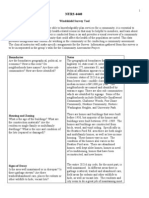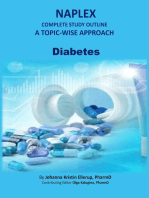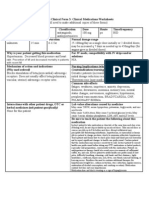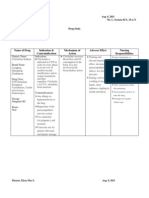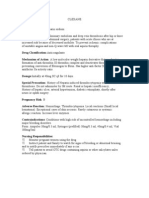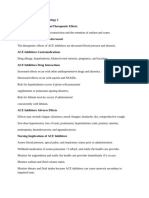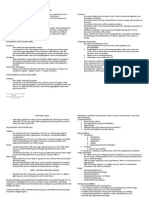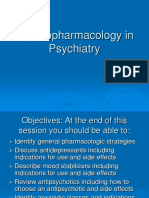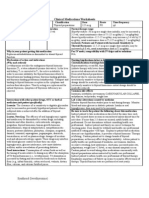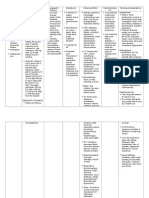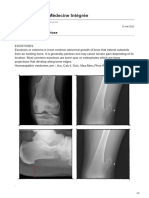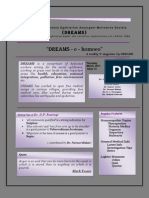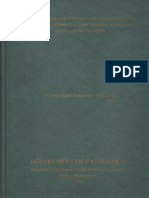Quetiapine
Quetiapine
Uploaded by
Michael KuzbytCopyright:
Available Formats
Quetiapine
Quetiapine
Uploaded by
Michael KuzbytOriginal Description:
Original Title
Copyright
Available Formats
Share this document
Did you find this document useful?
Is this content inappropriate?
Copyright:
Available Formats
Quetiapine
Quetiapine
Uploaded by
Michael KuzbytCopyright:
Available Formats
Clinical Medications Worksheets
Generic Name quetiapine Peak unknown Trade Name Seroquel Onset unknown Classification Antipsychotic Duration 8-12 hrs Dose Route Time/frequency 2 tab 25 mg PO Q am 50 mg total PO 830 Normal dosage range 100 mg/day in two divided doses on day 1, increase dose by 100 mg/day up to 400 mg/day by day 4, then may increase in 200 mg/day increments up to 800 mg/day on day 6 if required. For IV meds, compatibility with IV drips and/or solutions N/A Nursing Implications (what to focus on) Contraindications/warnings/interactions Hypersensitivity. Cardiovascular disease, cerebrovascular disease, dehydration or hypovolemia (increased risk of hypotension). History of seizures, Alzheimers type dementia. Geriatric patients (may require doses; inappropriate use for dementia is associated with mortality), hepatic impairment (dosage reduction may be necessary), hypothyroidism (may be exacerbated). Common side effects NEUROLEPTIC MALIGNANT SYNDROME, SEIZURES, dizziness, weight-gain Lab value alterations caused by medicine May cause asymptomatic in AST and ALT. May also cause anemia, thrombocytopenia, leukocytosis, and leucopenia.
Why is your patient getting this medication Bipolar mania Mechanism of action and indications (Why med ordered) Probably acts by serving as an antagonist of dopamine and serotonin. Also antagonizes histamine H1 receptors and alpha1adrenergic receptors.
Interactions with other patient drugs, OTC or herbal medicines (ask patient specifically) Lantus: The efficacy of oral hypoglycemic agents and insulin may be diminished by certain drugs, including thiazides and other diuretics, corticosteroids, estrogens, progestins, thyroid hormones, human growth hormone, phenothiazines, atypical antipsychotics, sympathomimetic amines, protease inhibitors, phenytoin, clozapine, megestrol, danazol, isoniazid, asparaginase, pegaspargase, diazoxide, temsirolimus, as well as pharmacologic dosages of nicotinic acid and adrenocorticotropic agents. These drugs may interfere with blood glucose control because they can cause hyperglycemia, glucose intolerance, new-onset diabetes mellitus, and/or exacerbation of preexisting diabetes. Nitroglycerin: Neuroleptic agents may potentiate the hypotensive effect of some medications secondary to their peripheral alpha-1 adrenergic blocking activity. Orthostatic hypotension and syncope associated with vasodilation may occur, particularly during the initial dose titration period of neuroleptic therapy. Proventil, Levaquine: There is some concern that quetiapine may have additive adverse cardiovascular effects in combination with other drugs that are known to prolong the QT interval of the electrocardiogram. Data are conflicting. In clinical trials, there was no statistically significant difference between quetiapine and placebo in the proportions of patients experiencing potentially important changes in ECG parameters including QT, QTc, and PR intervals. However, QT prolongation has been reported in quetiapine overdose and with therapeutic use of other atypical antipsychotic agents such as sertindole, ziprasidone, and risperidone. In one case report, torsade de pointes arrhythmia developed in a patient treated with low-dose quetiapine. However, the relationship to quetiapine is uncertain, as there were multiple confounding risk
May cause total cholesterol and triglycerides
Be sure to teach the patient the following about this medication Instruct patient to take medication as directed. Inform patient of the possibility of extrapyramidal symptoms. Instruct patient to report symptoms immediately to health care professional. Advise patient to change positions slowly to minimize orthostatic hypotension. May cause drowsiness. Caution patient to avoid driving or other activities requiring alertness until response to medication is known. Advise patient to avoid extremes in temperature; this drug impairs body temperature regulation. Caution patient to avoid concurrent use of alcohol, other CNS depressants, and OTC or herbal medications without consulting health care professional. Advise patient to notify health care professional of medication regimen before treatment or surgery. Instruct patient to notify health care professional promptly of sore throat, fever, unusual bleeding or bruising, or rash. Emphasize need for continued follow-up for psychotherapy and monitoring for side effects. Ophthalmologic exams should be performed before and every 6 months during therapy.
Seroquel (quetiapine)
factors such as hypomagnesemia, a history of QT prolongation (possibly prior to initiation of quetiapine), a history of substance abuse, and uncertain medication compliance. In general, the risk of an individual agent or a combination of agents causing ventricular arrhythmia in association with QT prolongation is largely unpredictable but may be increased by certain underlying risk factors such as congenital long QT syndrome, cardiac disease, and electrolyte disturbances (e.g., hypokalemia, hypomagnesemia). In addition, the extent of drug-induced QT prolongation is dependent on the particular drug(s) involved and dosage(s) of the drug(s). Coreg, Demadex: Neuroleptic agents may potentiate the hypotensive effect of some medications secondary to their peripheral alpha-1 adrenergic blocking activity. Orthostatic hypotension and syncope associated with vasodilation may occur, particularly during the initial dose titration period of neuroleptic therapy. Gabapentin: Central nervous system- and/or respiratorydepressant effects may be additively or synergistically increased in patients taking multiple drugs that cause these effects, especially in elderly or debilitated patients. Reglan: Coadministration of metoclopramide with phenothiazines or other neuroleptic agents may increase the risk of severe extrapyramidal reactions. The mechanism is additive antidopaminergic effects. In addition, central nervous system-depressant effects may be additively or synergistically increased in patients taking multiple drugs that cause these effects, especially in elderly or debilitated patients. Grapefruit juice: Grapefruit juice may increase the plasma concentrations of some orally administered drugs that are substrates of the CYP450 3A4 isoenzyme. The proposed mechanism is inhibition of CYP450 3A4-mediated first-pass metabolism in the gut wall by certain compounds present in grapefruits. The extent and clinical significance are unknown. Moreover, pharmacokinetic alterations associated with interactions involving grapefruit juice are often subject to a high degree of interpatient variability. Nursing Process- Assessment Assessment (Pre-administration assessment) Why would you hold or not give this med? Monitor mental status (mood, ideation, delusions, Monitor for development of neuroleptic hallucinations, behavior) before and periodically malignant syndrome (fever, respiratory during therapy. Monitor mood changes. Assess distress, tachycardia, seizures, diaphoresis, for suicidal tendencies, especially during early hypertension or hypotension, pallor, therapy. Restrict amount of drug available to tiredness). Notify physician or other health patient. Monitor blood pressure (sitting, standing, care professional immediately if these lying) and pulse before and frequently during symptoms occur. Hypersensitivity. Seizure. initial dose titration. If hypotension occurs during dose titration, return to the previous dose. Observe patient carefully when administering to ensure medication is swallowed and not hoarded. Monitor for onset of extrapyramidal side effects (akathisia--restlessness;dystonia--muscle spasms and twisting motions; or pseudoparkinsonism-mask-like faces, rigidity, tremors, drooling, shuffling gait, dysphagia). Report these symptoms;
Evaluation Check after giving Decrease in excited, manic, paranoiac or withdrawn behavior. Make sure patient has swallowed medication and is not cheeking or holding meds.
Seroquel (quetiapine)
reduction of dose or discontinuation may be necessary. Trihexyphenidyl or diphenhydramine may be used to control these symptoms. Monitor for tardive dyskinesia (involuntary rhythmic movement of mouth, face, and extremities). Report immediately; may be irreversible.
Seroquel (quetiapine)
You might also like
- Windshield Survey TemplateDocument6 pagesWindshield Survey TemplateMichael Kuzbyt100% (1)
- Windshield Survey ToolDocument8 pagesWindshield Survey Toolkenneth_rhea100% (1)
- Windshield Survey ToolDocument8 pagesWindshield Survey Toolkenneth_rhea100% (1)
- TVP-2020-1112 Managing Feline Urethral ObstructionDocument6 pagesTVP-2020-1112 Managing Feline Urethral ObstructionLucas Dos Santos MacedoNo ratings yet
- Drug Study TramadolDocument14 pagesDrug Study TramadolBianca Freya Porral85% (13)
- RisperdalDocument2 pagesRisperdalAdrianne Bazo100% (1)
- Naplex Complete Study Outline A Topic-Wise Approach DiabetesFrom EverandNaplex Complete Study Outline A Topic-Wise Approach DiabetesRating: 4 out of 5 stars4/5 (3)
- ZopicloneDocument2 pagesZopicloneMichael KuzbytNo ratings yet
- Venlafaxine XRDocument2 pagesVenlafaxine XRMichael Kuzbyt100% (1)
- XareltoDocument2 pagesXareltoMichael Kuzbyt100% (1)
- Venlafaxine XRDocument2 pagesVenlafaxine XRMichael Kuzbyt100% (1)
- XareltoDocument2 pagesXareltoMichael Kuzbyt100% (1)
- The Ride of Your Life: What I Learned about God, Love, and Adventure by Teaching My Son to Ride a BikeFrom EverandThe Ride of Your Life: What I Learned about God, Love, and Adventure by Teaching My Son to Ride a BikeRating: 4.5 out of 5 stars4.5/5 (2)
- COMPREHENSIVE NURSING ACHIEVEMENT TEST (RN): Passbooks Study GuideFrom EverandCOMPREHENSIVE NURSING ACHIEVEMENT TEST (RN): Passbooks Study GuideNo ratings yet
- Clinical Medications WorksheetsDocument3 pagesClinical Medications WorksheetsVinz OñoNo ratings yet
- Seroquel (Quetiapine)Document3 pagesSeroquel (Quetiapine)E100% (1)
- ANTIPSYCHOTICS Olanzapine (Zyprexa), Aripiprazole (Abilify), Chlorpromazine (Thorazine)Document5 pagesANTIPSYCHOTICS Olanzapine (Zyprexa), Aripiprazole (Abilify), Chlorpromazine (Thorazine)Rhanne BolanteNo ratings yet
- Drugs For Substances AbuseDocument4 pagesDrugs For Substances AbuseAriadne MangondatoNo ratings yet
- MM MM MM MM MMM MMMMM M MM M MMMM MMMMM MMM MM MMM MM!M M!"M#MM MM M $M M %MMM MM "M "MM M MMM MDocument9 pagesMM MM MM MM MMM MMMMM M MM M MMMM MMMMM MMM MM MMM MM!M M!"M#MM MM M $M M %MMM MM "M "MM M MMM M배기숭No ratings yet
- Metoclopromide Drug StudyDocument4 pagesMetoclopromide Drug Studymarklesterdeguzman087No ratings yet
- Aripiprazole AbilifyDocument2 pagesAripiprazole AbilifyKristi Wray100% (2)
- Drug StudyDocument12 pagesDrug StudyAngeli A EstilloreNo ratings yet
- Coreg (Carvedilol) 6.25mgDocument3 pagesCoreg (Carvedilol) 6.25mgE100% (2)
- Drug Study-Grand Case PresDocument8 pagesDrug Study-Grand Case PresLorina Lynne ApelacioNo ratings yet
- FluphenazineDocument3 pagesFluphenazineKaren T. CeletariaNo ratings yet
- Adrenergic AntagonistsDocument8 pagesAdrenergic AntagonistsmysterioushumaneNo ratings yet
- Pharmacology HESI Study Guide 2013Document16 pagesPharmacology HESI Study Guide 2013naijababy89100% (12)
- Adrenergic Blockers AtenololDocument3 pagesAdrenergic Blockers AtenololPoinsithia OrlandaNo ratings yet
- Specific Drug Olanzapine (Classification IndicationDocument14 pagesSpecific Drug Olanzapine (Classification IndicationRIZZA JANE VELASCONo ratings yet
- Lopressor (Metoprolol) 100mgDocument2 pagesLopressor (Metoprolol) 100mgAdrianne Bazo100% (2)
- Labs Drug Study 1Document17 pagesLabs Drug Study 1Drei LanuzoNo ratings yet
- Fluvoxamine MaleateDocument3 pagesFluvoxamine MaleateHilman Fitriaji Suganda PrawiraNo ratings yet
- Name of Drug/ Therapeutic Class Action Indications Side Effect Nursing Considerations ParacetamolDocument7 pagesName of Drug/ Therapeutic Class Action Indications Side Effect Nursing Considerations ParacetamolAnne Monique Moran OngjocoNo ratings yet
- Psych Drug StudyDocument5 pagesPsych Drug StudyLorina Lynne Apelacio100% (4)
- Drug Study FORTDocument3 pagesDrug Study FORTLysa Mae EleazarNo ratings yet
- PerindoprilDocument3 pagesPerindoprilWeng Maesa MontemayorNo ratings yet
- Of Angina Pectoris. Decreased Rate of Cardiovascular Mortality and Hospitalization in Patients With Heart FailureDocument31 pagesOf Angina Pectoris. Decreased Rate of Cardiovascular Mortality and Hospitalization in Patients With Heart Failurenaikram420No ratings yet
- PropanolDocument8 pagesPropanolStacey CamilleNo ratings yet
- Trandate (Labetalol)Document3 pagesTrandate (Labetalol)ENo ratings yet
- Drug Study 2Document8 pagesDrug Study 2rey_tengNo ratings yet
- Important Notes Pharmacology 2Document26 pagesImportant Notes Pharmacology 2Salv FuentNo ratings yet
- Tramadol HCLDocument4 pagesTramadol HCLCherrylyn FerrerNo ratings yet
- P-Mid Midterm ExamDocument10 pagesP-Mid Midterm ExamIan Mizzel A. DulfinaNo ratings yet
- Drug StudyDocument5 pagesDrug StudyCrystal Joy MisaNo ratings yet
- Psychopharmacology in PsychiatryDocument94 pagesPsychopharmacology in PsychiatryOslo Saputra100% (1)
- HaldolDocument6 pagesHaldolJon ChuaNo ratings yet
- Propranolol Hydro ChlorideDocument4 pagesPropranolol Hydro Chlorideapi-3797941No ratings yet
- Synthroid (Levothyroxine)Document2 pagesSynthroid (Levothyroxine)E100% (2)
- S 030 LblmineDocument14 pagesS 030 LblmineLeslie HouseNo ratings yet
- Medications For The ElderlyDocument8 pagesMedications For The ElderlyShawn TaylorNo ratings yet
- Diazepam, Lanoxin, Hemostan, NaprexDocument6 pagesDiazepam, Lanoxin, Hemostan, NaprexRene John Francisco100% (1)
- Medication Worksheet: (You Will Need To Make Additional Copies of This Form)Document2 pagesMedication Worksheet: (You Will Need To Make Additional Copies of This Form)mcarter402100% (2)
- SeroquelDocument1 pageSeroquelE100% (1)
- Drug StudyDocument22 pagesDrug StudyColleen Fretzie Laguardia NavarroNo ratings yet
- Propylthiouracil DSDocument6 pagesPropylthiouracil DSAlexandrea MayNo ratings yet
- Nortriptyline Tablets Prescribing InformationDocument10 pagesNortriptyline Tablets Prescribing InformationMirza MarufNo ratings yet
- Lyks - Part 7 Drug StudyDocument6 pagesLyks - Part 7 Drug StudyLuige AvilaNo ratings yet
- DrugsDocument5 pagesDrugsnurse_nurseNo ratings yet
- CLOZAPINEDocument5 pagesCLOZAPINEMar OrdanzaNo ratings yet
- Coreg (Carvedilol)Document3 pagesCoreg (Carvedilol)ENo ratings yet
- Metoprolol and AmiodaroneDocument5 pagesMetoprolol and AmiodaroneNolte BombayNo ratings yet
- Flouxetine Drug StudyDocument7 pagesFlouxetine Drug Studyhello poNo ratings yet
- Medical Encyclopedia XXL: Prof. J.P. Schadé, M.D., Ph.D. D.Sc.hcFrom EverandMedical Encyclopedia XXL: Prof. J.P. Schadé, M.D., Ph.D. D.Sc.hcNo ratings yet
- Critical Care Medications: Anti-Arrhythmics Study Guide: Critical Care EssentialsFrom EverandCritical Care Medications: Anti-Arrhythmics Study Guide: Critical Care EssentialsNo ratings yet
- Simplifying Psychiatric Documentation: Time-Saving Templates for Medication RecommendationsFrom EverandSimplifying Psychiatric Documentation: Time-Saving Templates for Medication RecommendationsNo ratings yet
- Top 100 Drugs Pocket Reference Guide (2023 Edition)From EverandTop 100 Drugs Pocket Reference Guide (2023 Edition)No ratings yet
- RamiprilDocument3 pagesRamiprilMichael KuzbytNo ratings yet
- VerapamilDocument2 pagesVerapamilMichael KuzbytNo ratings yet
- Aminoxin: Clinical Medications WorksheetsDocument1 pageAminoxin: Clinical Medications WorksheetsMichael KuzbytNo ratings yet
- Hypervolemia Hypovolemia For StudentsDocument2 pagesHypervolemia Hypovolemia For StudentsMichael KuzbytNo ratings yet
- IsoniazidDocument2 pagesIsoniazidMichael Kuzbyt100% (1)
- TelmisartanDocument2 pagesTelmisartanMichael Kuzbyt100% (1)
- BetamethasoneDocument3 pagesBetamethasoneMichael KuzbytNo ratings yet
- MultivitaminDocument1 pageMultivitaminKatie McPeek88% (8)
- AtenololDocument2 pagesAtenololMichael Kuzbyt100% (1)
- VerapamilDocument2 pagesVerapamilMichael KuzbytNo ratings yet
- Latanoprost XalatanDocument1 pageLatanoprost XalatanMichael KuzbytNo ratings yet
- Clinical Medications WorksheetsDocument2 pagesClinical Medications WorksheetsMichael Kuzbyt0% (1)
- Aminoxin: Clinical Medications WorksheetsDocument1 pageAminoxin: Clinical Medications WorksheetsMichael KuzbytNo ratings yet
- Dipimide: Clinical Medications WorksheetsDocument2 pagesDipimide: Clinical Medications WorksheetsMichael KuzbytNo ratings yet
- MorphineDocument1 pageMorphineMichael Kuzbyt100% (1)
- Interpretation of Up & Go Test For Older AdultsDocument1 pageInterpretation of Up & Go Test For Older AdultsMichael KuzbytNo ratings yet
- Ferrous GluconateDocument2 pagesFerrous GluconateMichael Kuzbyt0% (1)
- Milk of MagnesiaDocument1 pageMilk of MagnesiaMichael KuzbytNo ratings yet
- PrednisoneDocument1 pagePrednisoneCassieNo ratings yet
- LorazepamDocument1 pageLorazepamMichael KuzbytNo ratings yet
- SennaDocument1 pageSennaMichael KuzbytNo ratings yet
- AtorvastatinDocument2 pagesAtorvastatinMichael Kuzbyt100% (4)
- 四下micro 2Document77 pages四下micro 2q124415669No ratings yet
- ACLS Written 2006 Precourse Self AssessmentDocument14 pagesACLS Written 2006 Precourse Self AssessmentmonickamsNo ratings yet
- Question BankDocument28 pagesQuestion Bankas3941asNo ratings yet
- Parkinson's Disease Pathogenesis and Clinical AspectsDocument194 pagesParkinson's Disease Pathogenesis and Clinical AspectsSachin Raut100% (1)
- Compressive AtiDocument9 pagesCompressive Atiserahjayne100% (20)
- Anti Leprosy DrugsDocument18 pagesAnti Leprosy DrugsRupali RautNo ratings yet
- Tagma Khamsa PDFDocument23 pagesTagma Khamsa PDFIbad Ur RahmanNo ratings yet
- Consulatation Liaison Psychiatry English Lecture 2012 10Document58 pagesConsulatation Liaison Psychiatry English Lecture 2012 10Vean Doank100% (1)
- Nursing Care Plan Assessment Explanation of The Problem Goals and Objectives Intervention Rationale EvaluationDocument10 pagesNursing Care Plan Assessment Explanation of The Problem Goals and Objectives Intervention Rationale EvaluationGuile RilleraNo ratings yet
- Ostéophytose - Médecine IntégréeDocument2 pagesOstéophytose - Médecine IntégréeKungfudjusuModerneWushuNo ratings yet
- 11 Obstetrics Gynaecology 1Document54 pages11 Obstetrics Gynaecology 1mobashwer ahmedNo ratings yet
- Granulo 3Document94 pagesGranulo 3Sathvika BNo ratings yet
- The Colleges of Medicine of South AfricaDocument4 pagesThe Colleges of Medicine of South AfricaJustine NyangaresiNo ratings yet
- DIAGNOSIS AND MANAGEMENT OF ALLERGY-Dr - Dr.alvina Widhani, SpPD-KAIDocument24 pagesDIAGNOSIS AND MANAGEMENT OF ALLERGY-Dr - Dr.alvina Widhani, SpPD-KAIinhouseclinic grandhyattbaliNo ratings yet
- Nerve Supply of Head and NeckDocument74 pagesNerve Supply of Head and NeckDr Komal GhiyaNo ratings yet
- Active Recall Neuroanatomy 4B1LEDocument8 pagesActive Recall Neuroanatomy 4B1LEAlexandryaHaleNo ratings yet
- Preparation and Evaluation of Immediate Release TabletsDocument9 pagesPreparation and Evaluation of Immediate Release TabletsEditor IJTSRDNo ratings yet
- "DREAMS - e - Homoeo": (D Rea MS)Document6 pages"DREAMS - e - Homoeo": (D Rea MS)Saurav AroraNo ratings yet
- DR - Dr. Halida Wibawaty SP.M (K)Document23 pagesDR - Dr. Halida Wibawaty SP.M (K)anita awNo ratings yet
- Jurnal 10 PDFDocument8 pagesJurnal 10 PDFFirman MufidNo ratings yet
- IRIS CAT Treatment Recommendations 2023Document17 pagesIRIS CAT Treatment Recommendations 2023Haniel MonteiroNo ratings yet
- Fungi: Galactomannan and 1,3-β - Glucan Testing for the Diagnosis of Invasive AspergillosisDocument8 pagesFungi: Galactomannan and 1,3-β - Glucan Testing for the Diagnosis of Invasive AspergillosisntnquynhproNo ratings yet
- Ple TipsDocument14 pagesPle TipsChristine Evan Ho100% (2)
- Thesis of Dr. AKM Maruf Raza PDFDocument95 pagesThesis of Dr. AKM Maruf Raza PDFMaruf Raza DarubagiNo ratings yet
- Nursing Licensure Exam Compilation of TipsDocument3 pagesNursing Licensure Exam Compilation of TipsIkarishinNo ratings yet
- Neuropathology of SchizophreniaDocument10 pagesNeuropathology of SchizophreniaSabrina JonesNo ratings yet
- Dengue Drug Study and NCPDocument22 pagesDengue Drug Study and NCPLadybelle GototosNo ratings yet
- STI Syndromic ApproachDocument52 pagesSTI Syndromic ApproachBiyyaol AbiNo ratings yet
- Physiotherapy in Skin ConditionDocument7 pagesPhysiotherapy in Skin ConditionVinay KumarNo ratings yet

